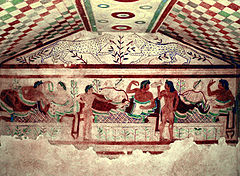Monterozzi necropolis
Necropoli dei Monterozzi | |
 Painting: Tomb of the Leopards | |
| Location | Tarquinia, Lazio, Italy |
|---|---|
| Region | Etruria |
| Coordinates | 42°15′02″N 11°46′12″E / 42.25056°N 11.77000°E |
| Type | Necropolis |
| History | |
| Founded | 7th century BC |
| Site notes | |
| Management | Soprintendenza per i Beni Archeologici dell'Etruria Meridionale |
| Website | Museum and Necropolis of Tarquinia and Cerveteri |
| Official name | Etruscan Necropolises of Cerveteri and Tarquinia |
| Type | Cultural |
| Criteria | i, iii, iv |
| Designated | 2004 (28th session) |
| Reference no. | 1158 |
| Region | Europe and North America |
The Monterozzi necropolis is an Etruscan necropolis on a hill east of Tarquinia in Lazio, Italy. The necropolis has about 6,000 graves, the oldest of which dates to the 7th century BC. About 200 of the gravestones are decorated with frescos.[1] Monterozzi was designated as a UNESCO World Heritage Site in 2004, notable as the depiction of daily life in the frescoed tombs, many of which are replicas of Etruscan houses, is a unique testimony to this vanished culture.

Description
The burial ground dates from the Iron Age, or Villanovan period (9th century BC), up to Roman times. From the Villanovan period simple round tombs carved from rock for cremation burials can be seen at the site.
Towards the end of the 8th c. BC, the first funerary chambers appeared as family tombs due to the rise to power of an aristocracy. These appeared on the surface as tumuli, sometimes assuming impressive proportions to enhance the power and prestige of the nobles, as can be seen especially in the so-called King and Queen tombs. There were about 600 tumuli still visible in the 19th century, following which many were razed after excavation.
The tumuli usually covered subterranean chambers carved into the rock, containing sarcophagi and personal possessions of the deceased, and many of which have wall paintings.
The earliest sarcophagi are carved with the image of the deceased supine on the lid. The later and more numerous types show him or her reclining on the left side, facing the spectator and frequently holding a libation vessel; occasionally a man displays an inscribed scroll listing his ancestry and the magisterial offices he occupied. During the second half of the 4th century BC sculpted and painted sarcophagi of nenfro, marble and alabaster came into use. They were deposited on rock-carved benches or against the walls in the now very large underground chambers.
Sarcophagi were also decorated with reliefs of symbolic or mythological content, often derived from Tarentine models. Sarcophagi of this type, which continue until the second century, are found in such numbers at Tarquinia that they must have been manufactured locally. The walls of the tomb-chambers of the late period are painted with underworld demons escorting the dead on their journey to the beyond, scenes in the nether world, processions of magistrates and other symbols of the rank of the eminent members of the families buried there.

Among the most notable painted tombs famous for the artistic quality of their frescoes are:
- the Tomb of the Leopards has some of the best preserved frescoes
- the Tomb of the Augurs
- the Tomb of Hunting and Fishing
- the Tomb of the Triclinium
- the Tomb of the Blue Demons
- the Tomb of the Bulls, the earliest tomb decorated with complex frescoes dated to either 540–530 BC or 530–520 BC. It is one of the rare Etruscan tombs which have erotic frescoes
- the Tomb of the Whipping. It is also one of the rare Etruscan tombs which have erotic frescoes.
- the Tomb of Orcus is notable for having the only known pictorial depiction of the Etruscan daemon Tuchulcha
- the Tomb of the Bigas
See also
References
- ^ "Monterozzi, Etruscan Necropolis". Etruscanplaces.net. Retrieved 15 October 2012.


